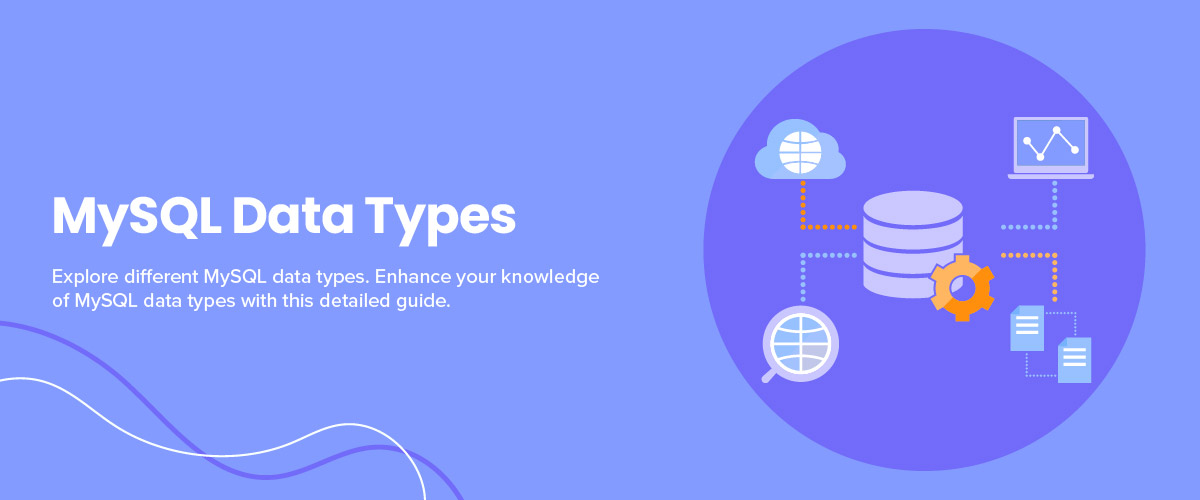Top 5 MySQL Data Types With Examples – 2025
MySQL, a popular open-source relational database management system, plays a crucial role in the world of web applications and data management. MySQL has increasingly solved problems for businesses, providing scalable, secure, and efficient data management solutions, and is used by millions of developers all over the world as the second most popular database system in the world, according to DB-Engine ranking. To effectively work with MySQL, it is essential to understand data types, their purpose, and how to choose the right one for optimal performance. This article will provide a comprehensive guide to MySQL data types, offering insights into their usage, best practices, and methods to convert them when necessary.
What are MySQL Data Types?
MySQL is a widely-used open-source RDBMS (relational database management system). Data types in MySQL are predetermined categories that help classify the kind of information that can be stored in a table column. This contributes to maintaining data consistency and accuracy, thus supporting data integrity.
In MySQL, data types are grouped into five main categories:
- Numeric data types
- Date and time data types
- String data types
- Spatial data types
- JSON data type
Also Read: What is SQL
Top 5 MySQL Data Types
1. Numeric Data Types
MySQL accommodates number types like integers, fixed points, and floating-Points.
A. Integer Types
MySQL offers various integer types that differ in storage size and range of values they can store:
| Integer Type | Storage (Bytes) | Signed Range | Unsigned Range |
|---|---|---|---|
| TINYINT | 1 | -128 to 127 | 0 to 255 |
| SMALLINT | 2 | -32,768 to 32,767 | 0 to 65,535 |
| MEDIUMINT | 3 | -8,388,608 to 8,388,607 | 0 to 16,777,215 |
| INT | 4 | -2,147,483,648 to 2,147,483,647 | 0 to 4,294,967,295 |
| BIGINT | 8 | -9,223,372,036,854,775,808 to 9,223,372,036,854,775,807 | 0 to 18,446,744,073,709,551,615 |
Integer types can be either UNSIGNED (allowing only positive values) or SIGNED (allowing both positive and negative values).
B. Fixed-Point Types
Fixed-point types are used to store exact numeric values with fixed decimal points. MySQL supports two fixed-point types:
- DECIMAL: Stores fixed-point numbers with a user-defined number of decimal places.
- NUMERIC: Alias for DECIMAL.
C. Floating-Point Types
Floating-point types are used to store approximate numeric values:
- FLOAT: A single-precision floating-point number.
- DOUBLE: A double-precision floating-point number.
2. MySQL Date and Time Data Types
MySQL offers various data types to handle date and time values:
- DATE: Stores date values in ‘YYYY-MM-DD’ format.
- TIME: Stores time values in ‘hh:mm:ss’ format.
- DATETIME: Stores combined date and time values in ‘YYYY-MM-DD hh:mm:ss’ format.
- TIMESTAMP: Stores the number of seconds since the Unix epoch (1970-01-01 00:00:00 UTC).
- YEAR: Stores year values as either a 2-digit or 4-digit format (ranges: 1901 to 2155 and 0000).
3. String Data Types in MySQL
In MySQL, string data types encompass a range of content from simple text to binary information like images or files. Comparison and search of strings can be performed using pattern matching through the LIKE operator, regular expressions, and full-text search methods.
Also Read: Different Types of SQL Commands
| String Types | Description |
|---|---|
| CHAR | A fixed-length nonbinary (character) string |
| VARCHAR | A variable-length non-binary string |
| BINARY | A fixed-length binary string |
| VARBINARY | A variable-length binary string |
| TINYBLOB | A very small BLOB (binary large object) |
| BLOB | A small BLOB |
| MEDIUMBLOB | A medium-sized BLOB |
| LONGBLOB | A large BLOB |
| TINYTEXT | A very small non-binary string |
| TEXT | A small non-binary string |
| MEDIUMTEXT | A medium-sized non-binary string |
| LONGTEXT | A large non-binary string |
| ENUM | An enumeration; each column value may be assigned one enumeration member |
| SET | A set; each column value may be assigned zero or more SET members |
4. Spatial Data Types
MySQL provides numerous spatial data types that hold diverse geometrical and geographical values, which are displayed in the table below:
| Spatial Data Types | Description |
|---|---|
| GEOMETRY | Any spatial value |
| POINT | A point (X-Y coordinates pair) |
| LINESTRING | A curve (one or more POINT values) |
| POLYGON | A polygon |
| GEOMETRYCOLLECTION | A collection of GEOMETRY values |
| MULTILINESTRING | A collection of LINESTRING values |
| MULTIPOINT | A collection of POINT values |
| MULTIPOLYGON | A collection of POLYGON values |
5. JSON Data Type
Since version 5.7.8, MySQL has included a built-in JSON data type, making it easier and more efficient to store and handle JSON documents. This native JSON data type offers automatic validation for JSON documents, as well as an ideal storage format.
A. Advantages of Using JSON Data Type
The JSON data type allows you to store and manipulate JSON (JavaScript Object Notation) data in MySQL. MySQL provides various built-in functions and operations to work with JSON data, such as JSON_OBJECT, JSON_ARRAY, JSON_SEARCH, JSON_MERGE, and JSON_VALID. It offers the following advantages:
- Flexibility in storing and retrieving complex and hierarchical data.
- Compatibility with various programming languages and tools.
- Built-in JSON functions and operations for searching, modifying, and validating JSON data.
How to Determine the Data Type in MySQL?
Start by identifying the specific traits of the data and then sort it into one of these categories based on those characteristics. To get a better understanding one can take up an SQL course. Follow these steps in MySQL to determine its data type:
- Determine if the values to be stored in the database are constant or changeable.
- Decide if the length of the values is consistent or variable.
- Evaluate if the values can be indexed or not.
- Think about how MySQL will compare the values within the data type.
After you’ve sorted your data based on these factors, you can select the suitable data type from those available in MySQL.
MySQL Best Practices for Selecting the Best Data Type
When selecting a data type for your table columns, the key principle is to pick one that best aligns with the range of accurate values for that column. To achieve this, follow these guidelines:
- For numeric data, opt for SMALLINT, INTEGER, BIGINT, or DECIMAL data types. DECFLOAT and FLOAT can be considered for extremely large numbers.
- For character data, choose between CHAR and VARCHAR data types.
- For date and time data, use DATE, TIME, and TIMESTAMP data types.
- For multimedia data, select GRAPHIC, VARGRAPHIC, BLOB, CLOB, or DBCLOB data types.
However, there may be exceptions. For instance, consider a social security number. While it is numeric, you won’t perform calculations with it, and it requires hyphens for proper formatting, which can’t be stored in numeric data types. Thus, the social security number serves as an exception.
Conclusion
Understanding data types in MySQL is critical for effective database design and management. In this article, we’ve provided a comprehensive guide to MySQL data types, their usage, best practices, and conversion methods. With this knowledge, you can make informed decisions when choosing data types and optimize your database for performance, scalability, and data integrity. We encourage you to explore further and experiment with different data types as you gain experience working with MySQL.






